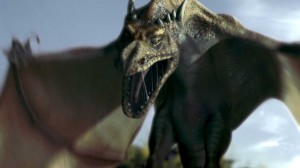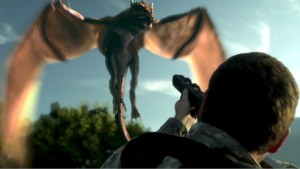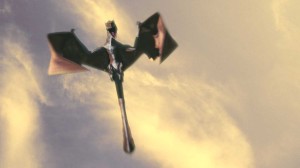
Burbank-based visual effects and postproduction boutique Rogue State was recently called on to deliver 220 visual effects shots for Dracano, working closely with Los Angeles-based Remember Dreaming Productions to realize this fantasy/action adventure movie for Odyssey Entertainment in Australia. A team of just three visual effects animators was able to deliver the film’s complicated visual effects shots in six weeks using LightWave 11.5, the latest release of NewTek’s 3D modeling and animation system.
In Dracano, a volcanic eruption in the Pacific Northwest spews lava, steam and fire – along with eggs that hatch ancient, menacing, winged dragons that prey on humans. Since similar volcanic eruptions in Russia, Japan and other “Ring of Fire” regions are also releasing these menacing creatures into the world, scientists fear they are witnessing the start of a global dragon apocalypse.
This ambitious plotline depends upon the credibility of the dragon creatures and their appearance, movement and interaction with people from a nearby U.S. military base who fight back.
LightWave 11.5 was used to create all of the CG dragons, military vehicles, helicopters and jets, as well as volcanic smoke, steam and lava. It was also the primary tool for creating the 220 live-action visual effects composites.
“There is no other 3D animation software out there with the breadth of features and ease of use to allow us to handle all of these visual effects shots for Dracano, given the tight time and budget constraints,” said Scott Wheeler, visual effects supervisor for Dracano and president of Rogue State.
 Wheeler added that new LightWave 11.5 features like Genoma for character rigging, Soft Body Bullet Dynamics and Motion Blur added to the Viewport Preview Renderer (VPR) system, are “invaluable tools for speeding up the process and streamlining the workflow on complex effects shots by a factor of 10.”
Wheeler added that new LightWave 11.5 features like Genoma for character rigging, Soft Body Bullet Dynamics and Motion Blur added to the Viewport Preview Renderer (VPR) system, are “invaluable tools for speeding up the process and streamlining the workflow on complex effects shots by a factor of 10.”
Wheeler explained that the Genoma character rigging system jump-starts the 3D modeling process by providing instant rigging of legs, arms, fingers, wings, spines and other body parts for biped, quadrupeds and even exotic creatures, like dragons. While Genoma provides a head start in creating 3D rigs, animators can modify these rigs or make any creative changes they may need.
“You’re basically just putting pre-programmed pieces together almost like an erector set to build your character,” Wheeler said. “There isn’t a lot of trial and error because once you set-up your creature in Modeler and export it to Layout, it just works exactly the way you’d expect it to.”
“Before Genoma, you’d actually have to build the rig in LightWave, starting with the bone structure in Modeler and then exporting a fully functioning rig to Layout,” Wheeler explained. “To do this, you’d have to have a solid understanding of how to build a good rig. With Genoma, an animator can rig a creature without having to understand the underpinnings of the process.”
Most of the CG dragons in Dracano are six to eight feet tall with a massive wingspan and sharp teeth. They range in size from baby dragons just hatched from eggs to a 150 to 200 foot tall mother dragon. The dragons have soft flesh covering their bodies and wings that move in relation to the rigid skeletal structure underneath. Soft hanging flesh can even jiggle as the creature moves, for greater realism. In LightWave 11.5, Genoma works in conjunction with another new feature, Soft Body Bullet Dynamics to produce this effect.
 LightWave 11.5 extends LightWave 11’s Bullet dynamics for rigid models to encompass flesh, cloth, rubber and other soft materials that deform. A dress can blow in the breeze even if the underlying model remains rigid because Genoma and Soft Body Bullet Dynamics understand the distinction between the two materials.
LightWave 11.5 extends LightWave 11’s Bullet dynamics for rigid models to encompass flesh, cloth, rubber and other soft materials that deform. A dress can blow in the breeze even if the underlying model remains rigid because Genoma and Soft Body Bullet Dynamics understand the distinction between the two materials.
“Bullet knows which surfaces to deform based on the weight maps and other parameters you set,” explained Wheeler. “These values are not the weight of the creature, they are values you set that define the degree of deformation you want to achieve.”
“It’s like mapping an object by making different areas different colors,” Wheeler said. “One color denotes a rigid structure while another color means that area needs to deform and move in relation to the rigid framework underneath. Genoma works with Bullet’s hard and soft body dynamics to figure out how much each object or surface should bend, collide, flop, wiggle, wave, stretch or any movement based on how you set it up.”
The Viewport Preview Renderer (VPR) that was introduced in LightWave 10 has also been extended in LightWave 11.5, making the rendering process much more efficient. Instead of seeing the animation as frame to frame to frame, like a stop-motion animation, motion blur gives a better, clearer sense of the animated motion and depth of field without having to go through the full rendering process. Motion blur on the VPR is not a visual effect, it’s a way to preview how the animation will actually look and integrate within the scene.
“With motion blur inside the VPR, you can get a feel for the speed of something that’s moving very fast, such as a dragon swooping by,” said Wheeler. “Since you can get a quick, accurate view of incremental creative enhancements without rendering, it saves a lot of time previously devoted to trial and error interspersed with rendering.”
In Dracano, many dragon creatures also take to the air and fly around or congregate in caves. Wheeler explained that they used Instancing to clone one dragon and create a group of 20 to 30 creatures.
“Flocking is best to move large numbers of creatures like a thousand wasps to form a deadly swarm,” Wheeler said. “But for a relatively small number of dragons, we used Instancing to create a group. LightWave lets you vary their attributes, like size or colors, and animate them independently of each other. Having a wide array of tools ensures that we have the right one for the unique challenges of every task.”
“In our segment of the market, creating visual effects for ultra-low or low-budget features, our visual effects team needs powerful, cost-effective 3D animation tools that get the job done quickly,” Wheeler said. “LightWave 3D helps us meet the production demands of budget-conscious producers without sacrificing the visual impact, credibility or realism of creatures or visual effects.”
Since launching in 2009, Rogue State has contributed visual effects, production and postproduction services to SyFy’s Dragon Wasps and Jules Verne’s Mysterious Island. Rogue State’s recent credits include Xtinction: Predator X (with K2 Pictures), Mega Piranha, The Adventures of Sinbad and Airline Disaster (with The Global Asylum). In 2011, Rogue State also co-produced Sand Sharks.





